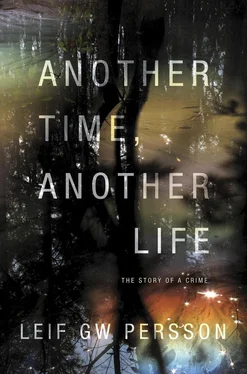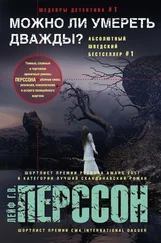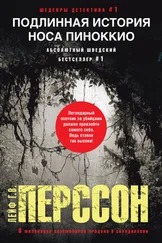The same day as the press release about her departure became public, the former bureau chief of the National Police Board Erik Berg passed away at a private nursing facility in Bromma.
During the spring the cancer had spread like a wildfire in his body, and on this particular day he had decided to release his hold. Now I’ll let go, he had thought. Let go so I can fall freely, like in a dream. And so he did.
Both Johansson and Berg’s old squire, Persson, attended the funeral.
Berg’s widow was there too, of course, but not many others, especially considering who Berg had been. The undersecretary, on the other hand, sat in the front pew in the church and surprised them all by showing visible signs during the funeral that he was deeply moved. On one occasion he even snuffled audibly and rubbed the corner of his eye with a giant handkerchief.
After the funeral service, when both Persson and Johansson were about to go their separate ways, the undersecretary came up to them and asked if he might invite them to lunch at Ulriksdals inn.
“I need a couple of good shots in the company of someone I can talk to, so I can gather my courage to say goodbye to Erik,” he explained. Johansson and Persson did not make any objections, but instead immediately accepted his invitation, and when they thought back on this afterward it really had been pleasant.
The following week Johansson met the undersecretary to ask him for a favor.
“I want a new job,” said Johansson.
“I’m sorry to hear that,” said the undersecretary, sounding as though he meant what he was saying. “What kind of job do you want?” he asked. “You can have whatever you want.” Finally, he thought.
Oh, well, thought Johansson.
“I’m a policeman,” said Johansson, “but these last twenty years I’ve mostly been involved with other things. Before I retire I would like to have a job where I get the opportunity to put away the occasional bad guy who has done ordinary, decent people harm. That was why I wanted to become a policeman in the first place,” Johansson concluded.
An extremely honorable ambition according to the undersecretary, and as far as the details were concerned he did not intend to interfere.
“If you give me a proposal, I’ll arrange it,” he said.
“Thanks,” said Johansson.
A week before Midsummer the chief inspector at the National Bureau of Investigation’s homicide squad, Evert Bäckström, entered the police hall of fame. The reason was that the almost eleven-year-old murder of Kjell Göran Eriksson had been cleared up after an almost heroic investigation by Bäckström. For once, and in the sphere in which the police department’s homicide investigators ordinarily live and act, it was also justified to describe the formidable investigative effort as having been solely thanks to Bäckström. It proved that Bäckström had been right the whole time. The murder of Eriksson was an almost classic gay murder, allowing for the fact that the perpetrator was, fortunately, a highly unusual gay.
The murder of Eriksson was yet another deed in an apparently endless series of senseless outrages with homosexual overtones and motives that had been committed by the now nationally known and even internationally renowned serial killer who went under the name the Säter-Man in the media — named after the well-known mental hospital in Dalarna where, by the way, he had spent more or less half his life.
Bäckström’s effort had come in the nick of time. During recent years public doubts about the guilt of Säter-Man had been growing at the same pace as the number of murders attributed to him had increased. As usual the media hadn’t picked up on the fact that “the critical voices” — that was how they preferred to describe themselves — consisted of an exceedingly mixed company of professional backbiters who made envy a virtue and raising doubts a meal ticket — but then the media and the backbiters were closely allied. True, the Säter-Man had already been convicted of half a dozen murders, but he had confessed to another thirty, and among those who had worked on the investigation there was a strong conviction that everything argued for this being only the “tip of the iceberg” and that there were thus indispensable values of criminal policy at stake.
A recurring theme in the criticism centered on the fact that the Säter-Man had always been convicted solely on his own admissions and without a shred of either witness testimony or technical evidence. Confessions that were alleged to have little in common with the actions he maintained he had committed. But Bäckström had succeeded where his colleagues had failed for more than ten years. He had silenced the critics and finally managed to create the peace and quiet necessary for continued, successful work.
For several years, long before he came to the National Bureau of Investigation, Bäckström had come, through his own persistent inquiries, to believe that the Säter-Man was also guilty of a series of five bestial knife murders of homosexual men that had been committed in Stockholm in 1989, and of which, moreover, the murder of Eriksson was the fourth. After lengthy questioning of the Säter-Man he got him to confess that in the early nineties he had access to an out-of-the-way, long since abandoned sheep pasture in northern Dalarna. “A holy place” that the Säter-Man frequented when he was “visited by elves and visions of the hereafter,” as soon as he managed to obtain the necessary permissions from the mental hospital to make “these pilgrimages to his inner borderland” possible in a purely practical sense.
Bäckström ordered a search of the sheep pasture in question and “in a cabin at the sheep pasture in question” had secured technical evidence that unambiguously and beyond any reasonable human doubt connected the Säter-Man to his victim Kjell Göran Eriksson. For one thing, a leather suitcase bearing the victim’s initials, for another a pair of terry-cloth hand towels, and finally a plastic bag from the tax-free shop at Kastrup Airport, that contained an unopened bottle of banana liqueur as well as the signed copy of the credit card receipt that showed that the referenced bottle had been purchased by the victim in September 1989, only a few months before he was murdered.
At the trial the Säter-Man had testified that the suitcase, hand towels, and banana liqueur were not the only things he had stolen from his victim. Besides numerous bottles of Eriksson’s alcohol he had emptied in his solitude up at the hut, he had also devoted himself to a number of videocassettes and a large number of magazines containing “brutally sadistic violent pornography of a homosexual nature.” He had later brought these pornographic works with him to the hospital after his leave was over, and there they had unfortunately been lost in the general handling. “I guess they were simply read to pieces,” he tearfully explained to the members of the court and other listeners.
Johansson and his wife had celebrated Midsummer in the city. The weather had been excellent, and after a nice dinner out at Djurgården they had walked home at a leisurely pace through the empty summer streets to their apartment on Wollmar Yxkullsgatan on Söder. As soon as they came into the hallway Johansson reached out his hand for the hollow in his wife’s neck and then... when at last they had wound up in bed, and at that point Johansson was already gliding from serene lethargy to deep and undisturbed sleep, his wife had something she absolutely had to say.
“Are you sleeping, Lars Martin?” she asked at the same time as she slowly drew the nails of her right hand through the hair on his neck.
Not any more, thought Johansson, because reality had just jerked him back.
“I was thinking about that Waltin,” she said.
Читать дальше












